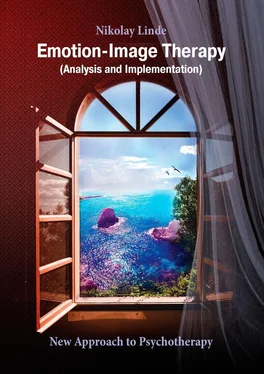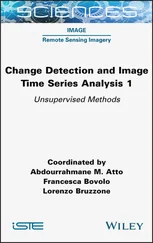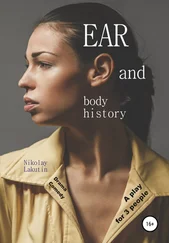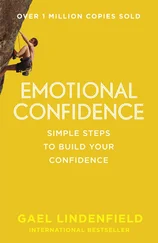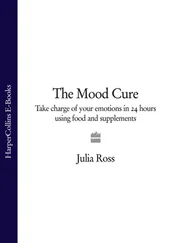Nikolay Linde - Emotion-Image Therapy. Analysis and Implementation
Здесь есть возможность читать онлайн «Nikolay Linde - Emotion-Image Therapy. Analysis and Implementation» — ознакомительный отрывок электронной книги совершенно бесплатно, а после прочтения отрывка купить полную версию. В некоторых случаях можно слушать аудио, скачать через торрент в формате fb2 и присутствует краткое содержание. ISBN: , Жанр: Здоровье, psy_generic, на английском языке. Описание произведения, (предисловие) а так же отзывы посетителей доступны на портале библиотеки ЛибКат.
- Название:Emotion-Image Therapy. Analysis and Implementation
- Автор:
- Жанр:
- Год:неизвестен
- ISBN:9785449698827
- Рейтинг книги:5 / 5. Голосов: 1
-
Избранное:Добавить в избранное
- Отзывы:
-
Ваша оценка:
- 100
- 1
- 2
- 3
- 4
- 5
Emotion-Image Therapy. Analysis and Implementation: краткое содержание, описание и аннотация
Предлагаем к чтению аннотацию, описание, краткое содержание или предисловие (зависит от того, что написал сам автор книги «Emotion-Image Therapy. Analysis and Implementation»). Если вы не нашли необходимую информацию о книге — напишите в комментариях, мы постараемся отыскать её.
Emotion-Image Therapy. Analysis and Implementation — читать онлайн ознакомительный отрывок
Ниже представлен текст книги, разбитый по страницам. Система сохранения места последней прочитанной страницы, позволяет с удобством читать онлайн бесплатно книгу «Emotion-Image Therapy. Analysis and Implementation», без необходимости каждый раз заново искать на чём Вы остановились. Поставьте закладку, и сможете в любой момент перейти на страницу, на которой закончили чтение.
Интервал:
Закладка:
Indeed, one can behave properly for a very long time, one can understand why and for what he does so, but if one remains his old self, with old emotional stereotypes, then in actual fact one’s false behavior is worth nothing. “Didn’t do any good, but in his soul, he was really a kind man” – said Pushkin about himself. And this is much better than to do some good remaining a wicked man.
What can do EIT in this sense? On the basis of the scheme of levels expressing the personality we can point out that therapy through emotions and images works for changing emotional states, which are the roots of psychological problems, as well as for rehabilitating the wholeness and harmony of a person’s essence. That means we work at a deeper level than thinking, behavior and even understanding. Rehabilitating the damaged essence makes it possible for a person to open up for himself the whole lot of new positive states which guarantee more effective and healthy life.
We help a person understand himself, do nothing “behind his back” which actually is impossible. Our method has nothing to do with hypnosis, rather it helps remove hypnotic-emotional states which emerged in the course of his life.
We do try to change the client’s behavior and thinking. We do indeed, but we always seek the underlying reason of his behavior and thinking, which appears to a problem for the client. We talk about and bodily expression of these feelings, about images of these feelings and at times it’s very surprising for the client. It is this that helps to achieve real, sincere and not imagined changes of behavior. We don’t teach the client how to behave but ask him what reactions occur involuntarily, when his emotional state has changed. If these reactions correspond to his desires as well as to lows of ecology and ethics, it is the best result in EIT. Sometimes the client is surprised that his reactions became quite different, though he doesn’t have time to think how to react properly. And this is the criterion of real changes!
In EIT realization and understanding for the client is secondary, primary is the changing if states, though the physician must understand what kind of changes he is trying to achieve, how some impact on the image can change the emotional state and personality. Everything is done for the good of the client, in compliance with psychological ecology, on condition of the client’s own agreement and using his own efforts. In the framework of EIT analyzing process is very quick, and the client’s insight is not forbidden, but it is more important for the physician. The physician’s insight is followed by a delightful “a-ha reaction” and the insight of the client is sometimes followed by the feeling of horror or remorse and by the rain of tears. He understands at last what terrible for him events and feelings brought him to this life, how he spoiled his life. But everything can be improved. It is never too late.
Summary
1. Emotions are the criterion of the success of a person’s activity, the criterion of success.
2. Emotions may be the main goal of some activity; it is performed in order to get emotions.
3. The way you feel is also an emotional phenomenon, expressing the state of your organism. Chronic emotions effect health.
4. Emotions provide energy for any actions of a person.
5. Emotional states make the basis for a person’s choice of thoughts and ways of behavior.
6. Negative emotions sometimes serve as social barriers for undesirable forms of thinking and behavior. But often they restrict positive capabilities of an individual.
7. Chronic negative emotions are the reason of disturbed psychological and psychosomatic health of a person, his inadequate behavior. They may remain unchanged in the person’s psyche all his life.
8. Psyche is active. Activity is being developed from within the personality. It proceeds from the essence and expresses itself through states, understanding, thinking and acts.
9. The task of EIT is to change chronic negative emotional states and work for integration and harmonization of a person’s essence.
Chapter 2. Emotions and body
Emotion is “a bridge” connecting psyche and body.
Emotion connects psyche and body; it exists both in psyche and in body at the same time. But emotion is also energy, which becomes revealed in actions. Emotion is felt subjectively but it is expressed in very strong bodily manifestations. They are more frequent or more slow heartbeat and breathing, tension or relaxation of muscles, more intensive or less intensive blood flow in some parts of the body, more intensive or less intensive sweating, discharging into blood some mediators [like adrenalin] and so on. Emotions affect the functioning of autonomous nervous system, which controls inner organism and does not follow the orders of the mind. That is why emotions strongly affect the states of the body and cause psychosomatic diseases.
Wilhelm Reich stated that undesirable emotions are blocked in the body by chronic muscle clamps [25, 26]. The system of these clamps makes up the so-called muscle shell. This shell not only restricts the expression of sincere feelings but also creates a barrier for spontaneous and flexible behavioral reactions. It blocks free flow of energy in the body, the amount of energy becomes smaller, feelings and behavior become limited, their repertory becomes much smaller. A person feels constant discomfort because of too much tension in his body, at times pain, sometimes the feeling of heaviness and limited mobility. Muscle clamp fully corresponds to adapting activity. It expresses the character of a person, that is of typical for him emotional and behavioral repertory with its limitations and stereotypes.
If the muscle clamp relaxes, the person gets back to his initial nature, becomes sincere and natural, flexible and creative. The heaviness of the body as if goes away, it becomes light, as if fresh wind were blowing inside the body. Energy and joy fill the person. He becomes capable of getting real pleasure from living, and his behavior is adequate, it corresponds to the situation, he doesn’t go crazy, on the contrary, he thinks clearly and fully realizes what is going on. We called this state of a person uncharacteristic, this is a new and unusual term requiring an explanation.
The matter is that character becomes revealed in customary and stereotypical ways of behavior, which repeat themselves in various situations, sometimes quite adequately and sometimes not. For example, a touchy person takes offence very often and as a rule when there is no reason to take offence. Touchiness is a trait of character. An anxious person is worrying for no reason; anxiety is his trait of character. A hot-tempered man is often outraged and feels insulted because of some trifle. Hot-temperedness is his trait of character. Any characteristic manifestations of a person are typical reactions excluding flexibility and creativity. A person lives within his character as a turtle in its shell. With the help of his character, he protects himself from his own shortcomings which he faces if he is open to the world. To do it he has to suppress some feelings and limit the repertory of possible actions straining the corresponding muscles of his body in fear of his own unlimited freedom. He is afraid if freedom and doesn’t know what to do with it.
But if he casts off the yoke of his character displayed in the muscle shell, not only his body relaxes but he no longer needs stereotype protective reactions. New spontaneous adequate to the current situation reactions become accessible to him. As he reacts creatively and not in a stereotype way you can’t say what kind of character he has. He is not touchy though but he may take offence if this is adequate to the situation as he really was insulted. But even feelings of offence don’t last long, he easily forgives them and goes on communicating normally. He is not anxious but may worry if future may have in store some unpredictable dangers. For example, if he has to take an important and difficult examination. But his worrying doesn’t last very long and is not pathological, doesn’t prevent from focusing on preparing for the examination.
Читать дальшеИнтервал:
Закладка:
Похожие книги на «Emotion-Image Therapy. Analysis and Implementation»
Представляем Вашему вниманию похожие книги на «Emotion-Image Therapy. Analysis and Implementation» списком для выбора. Мы отобрали схожую по названию и смыслу литературу в надежде предоставить читателям больше вариантов отыскать новые, интересные, ещё непрочитанные произведения.
Обсуждение, отзывы о книге «Emotion-Image Therapy. Analysis and Implementation» и просто собственные мнения читателей. Оставьте ваши комментарии, напишите, что Вы думаете о произведении, его смысле или главных героях. Укажите что конкретно понравилось, а что нет, и почему Вы так считаете.
